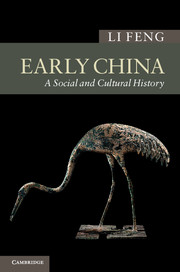Book contents
- Frontmatter
- Contents
- List of Figures
- List of Maps
- Preface
- Chronology of Early China
- Map
- 1 Introduction: Early China and its natural and cultural demarcations
- 2 The development of complex society in China
- 3 Erlitou and Erligang: early state expansion
- 4 Anyang and beyond: Shang and contemporary Bronze Age cultures
- 5 Cracking the secret bones: literacy and society in late Shang
- 6 The inscribed history: the Western Zhou state and its bronze vessels
- 7 The creation of paradigm: Zhou bureaucracy and social institutions
- 8 Hegemons and warriors: social transformation of the Spring and Autumn period (770–481 BC)
- 9 The age of territorial states: Warring States politics and institutions (480–221 BC)
- 10 Philosophers as statesmen: in the light of recently discovered texts
- 11 The Qin unification and Qin Empire: who were the terracotta warriors?
- 12 Expansion and political transition of the Han Empire
- 13 State and society: bureaucracy and social orders under the Han Empire
- 14 Ideological changes and their reflections in Han culture and Han art
- Index
- References
4 - Anyang and beyond: Shang and contemporary Bronze Age cultures
Published online by Cambridge University Press: 05 June 2014
- Frontmatter
- Contents
- List of Figures
- List of Maps
- Preface
- Chronology of Early China
- Map
- 1 Introduction: Early China and its natural and cultural demarcations
- 2 The development of complex society in China
- 3 Erlitou and Erligang: early state expansion
- 4 Anyang and beyond: Shang and contemporary Bronze Age cultures
- 5 Cracking the secret bones: literacy and society in late Shang
- 6 The inscribed history: the Western Zhou state and its bronze vessels
- 7 The creation of paradigm: Zhou bureaucracy and social institutions
- 8 Hegemons and warriors: social transformation of the Spring and Autumn period (770–481 BC)
- 9 The age of territorial states: Warring States politics and institutions (480–221 BC)
- 10 Philosophers as statesmen: in the light of recently discovered texts
- 11 The Qin unification and Qin Empire: who were the terracotta warriors?
- 12 Expansion and political transition of the Han Empire
- 13 State and society: bureaucracy and social orders under the Han Empire
- 14 Ideological changes and their reflections in Han culture and Han art
- Index
- References
Summary
If we were to point to an archaeological site that over the course of more than half a century has unceasingly offered sources of inspiration to researches in various disciplines in understanding the essentials of early Chinese civilization, it has to be Anyang. This immense Shang metropolis of some 24 km2 extending along the Huan River in northern Henan was not only the “cradle of Chinese archaeology,” but has also served as a firm base for the joint operation of text-inspired inquiries into the political history of the royal Shang state and studies that aim to clarify the characteristics of its material culture. Even since the beginning of the new century, Anyang has continued to offer a number of astonishing new discoveries that have significantly deepened our knowledge about the Shang state and civilization. As Anyang has just celebrated the eightieth anniversary of its discovery in 1928, its newly granted status as a “World Heritage Site” is indeed very richly deserved.
Discovering the Late Shang Dynasty
Beijing’s winter was cold in the years that witnessed the crumbling of the once glorious Manchu Empire when famine and malaria could easily take control over the streets of the imperial capital. Towards the end of 1899, Wang Yirong, President of the Imperial University, was terribly sick. His servant turned up what were known as the “dragon bones” among other prescribed ingredients in two bags which he brought back from a drugstore in the commercial street of southern Beijing. Already well known for his learning in traditional “Studies of Metal and Stone Inscriptions,” Wang immediately noticed that there were archaic forms of writing on these bones; therefore Wang sent his servant back to the drugstore and purchased the remaining several hundred pieces at a high price. After about eight months when the allied Western armies invaded Beijing, the fleeing Manchu court appointed Wang to command the remaining Qing troops to defend the capital. This was mission impossible! After foreign soldiers broke his line of resistance and entered the city, Wang saw no hope for the imperial city to survive the onslaught and thus committed suicide to preserve his loyalty to the emperor and his people.
- Type
- Chapter
- Information
- Early ChinaA Social and Cultural History, pp. 66 - 89Publisher: Cambridge University PressPrint publication year: 2013

